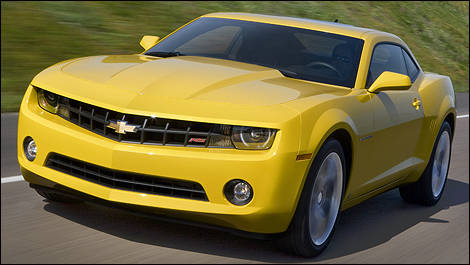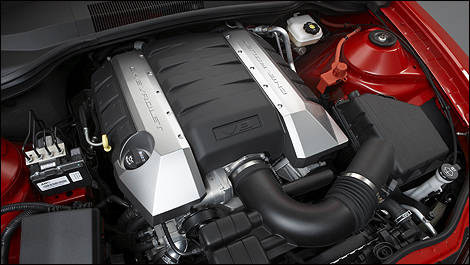Since the last new Camaro left us over seven years ago, Canadians were left with the Ford Mustang to fill the affordable muscle car niche. Things are about to change.
The 2010 Chevrolet Camaro comes alive with up to 426 horsepower and 420 lb-ft of torque from a 6.2-litre V8. Granted, many will opt for the 3.6-litre V6 in today's market, but that will still be good for 304 stallions. This rear-wheel drive Detroit will be delivered to us care of the Canadian assembly plant in Oshawa.
Just like the Pontiac G8, the 2010 Camaro has been engineered with the help of GM's Holden subsidiary in Australia - and this global teamwork may have been the only way to bring the Camaro into 2009 fruition. The Camaro shares some parts with its GM relatives: the SS' manual transmission is from the Corvette and the V6's automatic transmission is from the Cadillac CTS.
Regardless of engine choice, all 2010 Camaros will have six forward gears in either manual or automatic (with paddle shifters) guise. Gear ratios are unique to each setup. Only the automatic Camaro SS is fitted with cylinder deactivation, but this powertrain is limited to 6,000 rpm versus 6,600 rpm for the manual-equipped SS, and 7,000 rpm for the V6 models. Compared to the manual-equipped SS, the automatic SS' horsepower and torque ratings are down 26 and 10, respectively.
The V6 engine runs a government-calculated combined 9.8 litres per 100 km on regular unleaded. Conservative estimates for the premium-fuelled V8 add about a litre per 100 km for the SS, regardless of transmission.
Just like the Dodge Challenger, underneath the 2010 Camaro lies a fully independent suspension. This is, at least on paper, a better setup than the solid rear axle of the Mustang. Camaro SS models have altered suspension settings over the two V6 models.
The Camaro's stopping power comes from four disc brakes, but the SS model increases both the rotors' diameter by a couple of inches. The standard one-piston calipers are also replaced with brawny four-piston Brembo aluminum. Curb weights, which are balanced 52/48 front to rear, range from 1,687 kg for the automatic-equipped LT to 1,746 kg for the manual-equipped SS.
 |
| The 2010 Camaro has been engineered with the help of GM's Holden subsidiary in Australia. |
The 2010 Chevrolet Camaro comes alive with up to 426 horsepower and 420 lb-ft of torque from a 6.2-litre V8. Granted, many will opt for the 3.6-litre V6 in today's market, but that will still be good for 304 stallions. This rear-wheel drive Detroit will be delivered to us care of the Canadian assembly plant in Oshawa.
Just like the Pontiac G8, the 2010 Camaro has been engineered with the help of GM's Holden subsidiary in Australia - and this global teamwork may have been the only way to bring the Camaro into 2009 fruition. The Camaro shares some parts with its GM relatives: the SS' manual transmission is from the Corvette and the V6's automatic transmission is from the Cadillac CTS.
Regardless of engine choice, all 2010 Camaros will have six forward gears in either manual or automatic (with paddle shifters) guise. Gear ratios are unique to each setup. Only the automatic Camaro SS is fitted with cylinder deactivation, but this powertrain is limited to 6,000 rpm versus 6,600 rpm for the manual-equipped SS, and 7,000 rpm for the V6 models. Compared to the manual-equipped SS, the automatic SS' horsepower and torque ratings are down 26 and 10, respectively.
The V6 engine runs a government-calculated combined 9.8 litres per 100 km on regular unleaded. Conservative estimates for the premium-fuelled V8 add about a litre per 100 km for the SS, regardless of transmission.
Just like the Dodge Challenger, underneath the 2010 Camaro lies a fully independent suspension. This is, at least on paper, a better setup than the solid rear axle of the Mustang. Camaro SS models have altered suspension settings over the two V6 models.
The Camaro's stopping power comes from four disc brakes, but the SS model increases both the rotors' diameter by a couple of inches. The standard one-piston calipers are also replaced with brawny four-piston Brembo aluminum. Curb weights, which are balanced 52/48 front to rear, range from 1,687 kg for the automatic-equipped LT to 1,746 kg for the manual-equipped SS.
 |
| The Camaro comes alive with up to 426 horsepower and 420 lb-ft of torque from a 6.2-litre V8. |


